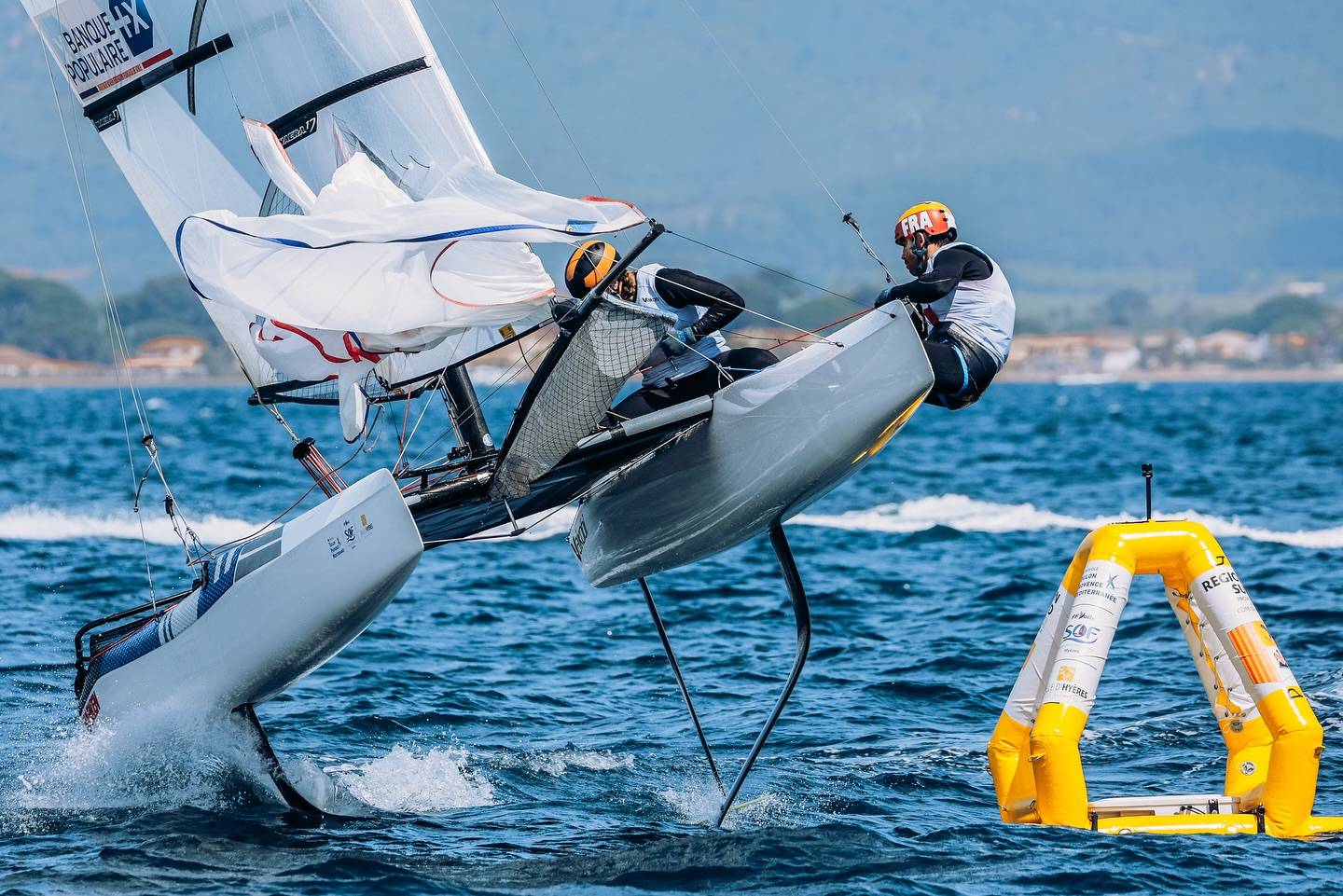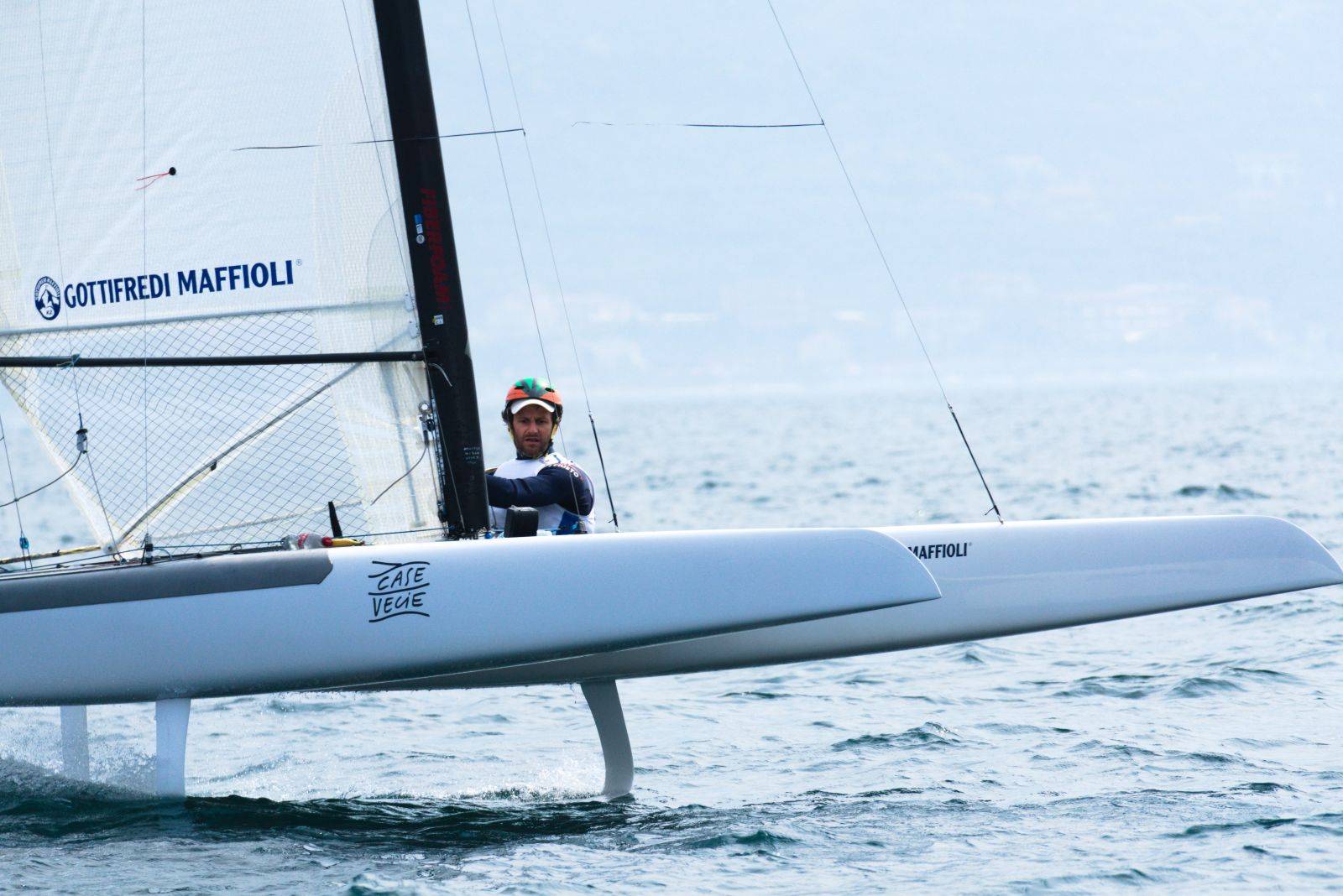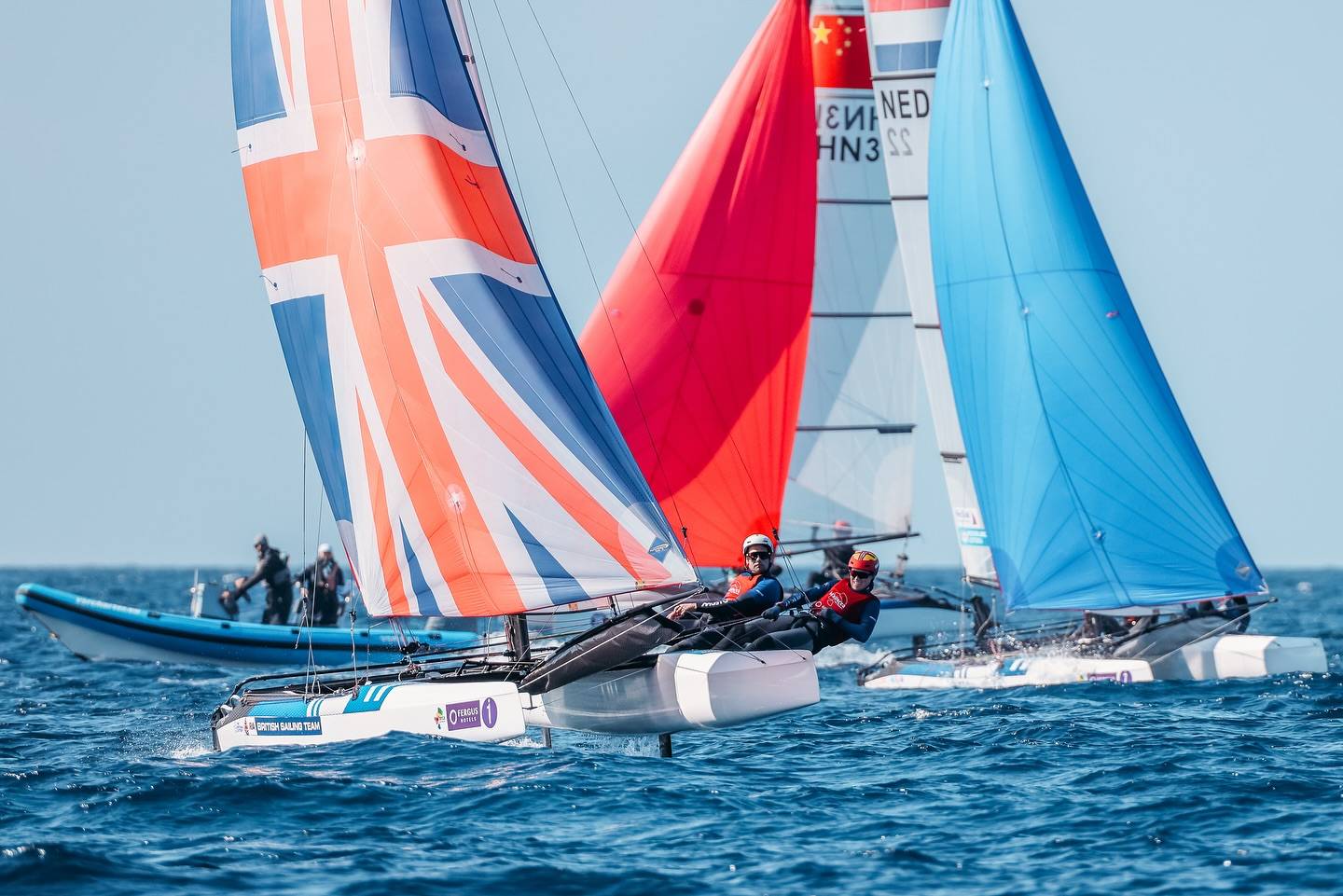Multihull Olympic Trials: 2,59cm Max Width (No Nacra F20 , no Tornado)
More info to come but ISAF has discarded the 20 footers, an F18 or F16 will likely be a chosen design.
And what about the two part mast? also 120-140kg range and a 20 foot container … sailing.org/tools/documents/MultihullRequestforProposal-%5B11321%5D.pdf
“…(a) Boat Characteristics:
2-person multihull type
Sloop rig with an Asymmetrical Spinnaker
FRP construction of hulls
Two part mast
Twin trapeze
Unsinkable when holed or swamped with approximately level flotation. The boat, when swamped, shall float with some portion of the freeboard, or deck above water
Easily righted by the crew without external help
Able to be shipped in a 6.1m (20ft) container
Trailerable maximum width 2.59m (8ft 6in)
(b) Performance – per the following approximate descriptions:
Racing is expected to be held in winds in the range 5 to 25 knots
Higher winds should reward the skill and experience of the sailor…”
“…it is desired that the sailors combined weight will be within the 120-140 kg range ”
“…(c) Disclaimer – Information presented in this Request for Proposal (RFP) is subject to change and that incurring expenses or beginning to formulate an approach in preparation for the selection based on information presented in the RFP is solely at the potential offerors risk….”
www.sailing.org/tools/documents/MultihullRequestforProposal-%5B11321%5D.pdf

























I have the feeling they are looking for a low performance boat…
Is there ANY performance catamaran currently available and competing en mass with a 2 Piece Mast? Perhaps IOC should be conducting the trials instead of ISAF
The trailable width is not an issue because the boat can be broken down.
The 20 foot container and two piece mast do however does rule the Tornado and F20 Carbon out.
I don't understand the two piece mast, surely these will leak and that contradicts the easy to right suggestion. How many boats have a two piece mast option?
It appears that ISAF are keen on saving money through shipping. I am assuming each team or country would be putting a rib for the coach into the container too. Surely they will just use 40 foot containers anyway.
Interesting set of requirements.
In response to Ryan, yes there is
https://en.wikipedia.org/wiki/Hobie_16
I dont know any federation that ships in 20ft containers, and further more ISAF seem to be looking for a super light crew weight, 120kg for a mixed team is to put it nicely: **** crazy! unless you want only mini people to be on the cats.
Don´t start insulting or bad naming bashing others, go to other forums for that.
Insulting ISAF is well justified! they have yet again made a screwup of OUR sport, remember they are responsible to US! and look what they have done. They clearly have lost touch with the sailing scene and spend too much time talking about the good old days or whatever it is they do at these things. But certainly they are not working for the future of sailing.
To my opinion, the isaf paper is close to perfect: a lightweight platform, that is easy to ship and challenging above 25 knots of wind. Parting a mast, that will still be waterproof and light is no technical but a financial issue. I'm shure, AHPC, Nacra and others will quickly find a solution to that part of the request. In fact, the only boat meeting the request at present is the Hobie 16 Spi, including the combined crew weight. Olympic candidates, say goodbye to Pasta and switch to Broccoli!
According to all the top Tornado sailors Viper and F16 is for "kindergarden".
The Hobie 16 will be nearly 50 years old !!!
Be serious, it is a boat for the olympics not for the youth ISAF world !!
The evaluation will include tacking. I don't think the Hobie 16 will do as well as newer designs in the eval.
The Viper of Nacra F16 would be great for an all female crew. It is on the small side for a mixed crew. I don't know how many mixed teams are actually as light as 120 kg. The ISAF seems to be out to lunch with the crew weight goal and with the need for 20 foot mast sections.
The best catamaran class and the best class for mixed multihull is still the F18. It is easily sailed by a teams from 130 to 150 kg, which would be a more realistic range for mixed teams.
The hobie 16 does not meet this 2 part mast requirement because the comp tip is extremely difficult to take off and then back on again. It is not made to take on and off repeatedly.
And why on earth would they throw out the 20 footers? WTF.
The worst would be if low performance Topcat is chosen. It has 2 part mast.
W
Dear Dr. Smithwick,
As somebody who has sailed multihulls since 1980 I looked at your RFP with dis-belief. If you require a boat that is in production today and has an international presence, you are asking for boats that are far inferior to the traditional equipment used today – both by recreational sailors and advanced. You apparently have the mis-conception that smaller is cheaper. This is absolutely not true when you consider the poorer quality materials that will make replacement of boats required more frequently. The better built boats last much longer (competitive on a world class level for as much as 10 years), can handle the extra demands on the mast and platform that flying a spinnaker requires, and over all are cheaper over the course of an Olympic campaign.
In addition, by virtue of your weight guidelines, you are eliminating many of the mixed crews that are among the best multihull sailors today.
It would seem that you have no experience with these boats as you request high performance boats that are built with inferior materials and have little chance of surviving an Olympic campaign. Why don't you require the existing Olympic disciplines to sail with inferior equipment and materials?
An reasonably tall (1.72 meters) athletic female will often tip the scale at 65kg or more. Your 130kg combined crew weight suggests that you would like only a world class marathon runner male (typically 32kg/meter) to fill out the other half of the mixed team.
I strongly urge you to reconsider your requirements for the Multihull RFP to represent the current body weight of todays young athletes as well as the quality of the equipment you require them to use for competition.
Sincerely,
James W. McCarthy
President of US Tornado Association (1997-2002)
Just so that people have some facts on which to base their posts, the following are some stats on Olympic sailor weights from the 2000 & 2004 Olympics.
I have excluded all events before 2000 as these were based on the single trapeze Tornado, and excluded 2008 as everyone slimmed down for what was expected to be a light weather venue.
Average weight of Tornado sailors (66 athletes across the two Olympiads): 73.8kg
Average weight of all women (likely pool of sailors for a mixed crew. This is average of 233 women in Mistral, Europe, 470, Yngling): 62.4kg
So if you were to take the average Tornado sailor weight plus the average female Olympian weight, the total would be 136.2kg.
And if you take into consideration that the Tornado fleet was made of mainly European background sailors and the intent is to encourage sailors from other areas such as Asia, then you might aim at a slightly lower weight than this.
Regards,
A numbers man
So there you go! The average weight for a mixed team would be 136kg, so why is that at the top of the range ISAF have selected?
Whilst we are numbers, where do you find a 120kg mixed team currently sailing?
Oops! My previous post I took the average Tornado sailor weights from 2000 & 2004, but the 2000 Tornado was still the single trap version. So average weights for 2004 with the twin trapeze version were only slightly different at 74.5kg.
When my wife and I sailed together in our early twenties, our sailing weight was 116kg and we had to carry 15kg of lead on the boat to get up to the minimum weight of on a Hobie 16. I'm 5'10", European background and wifey is 5'2", so not all that unusual a mix.
About a quarter of the fleet we sailed against carried weights on their boats.
One thing people have not mentioned is the sheet loads on a boat. If you choose an 18 or 20ft boat, then the sheet loads will pretty much dictate that the crew has to be the male of the pair.
Unless of course you have a wing mast …… then the loads are significantly less.
Umm that means if your wife weighed 51kg, you only weighed 65kg… both well below the average of athletic westerners.
And as for sheet loads, you are aware that the boat to be chosen is for an event called "The Olympics" and as such it is not meant to be easy, you will need to be an "athlete" to sail it. If you want to have a nice sunday sail, pick another boat.
If we stay with the 120-140kgs in the evaluation rules, Olympic mixed sailing is dead before it startet. More than 50% of actual mixed teams weigh more than 140kg. In the last Olympic Games (Sydney, Athen, Qingdao) crazy diets, bulimia and eating disorders were the case in some Olympic classes to get the weights downs. Better check real weight statistic at https://www.mixedsailing.org/perfect-weight-range/ The average women is around 65 and men around 78kg. Europeans/Americans/Africans/Ozeanians a bit over and Asians under. Also if we go some kgs lower in average, we end up around 140kg average for a mixed team. Its should be 130-150kg target and not down to 120kg. This is purely a joke and exclude the F18 and Tornado with most the mixed teams. If we go under 18 Foot cat, Olympic mixed sailing is dead from the beginning.
Anonymous
The best F16 these days are by no mean kindergarden boats. At the F16 worlds this year Bundy won. Go and tell to his face that he is in kindergarden if you dare
I guess you never sailed a Viper, maybe you should try
The F16 is perfect for a womens or a youth boat, but the weights for top level teams will be too low on the F16 to be a viable long term mixed discipline choice. Does anyone aspire to grow up and be a 470 helm? Even those guys hate the fact that they can't eat properly for 4 years at a time.
Bundy knows this, but the $$ will alter his statements from now on.
Weights for the top 3 teams at the F16 Worlds this year were 138, 141 and 140kg for a Mixed, All Male, and Mixed crews. Compare this to Hagara who sailed at 137kg and 144kg in the 2000/2004 Olympics.
So going by that, it suggests that the F16 has a higher weight requirement than most people think (I've never sailed one!). And maybe the ISAF target is a bit low even for the F16.
Then again, all competitors were of European background, and they are trying to encourage people from outside of European background, e.g. Asia.
The minimum weight for a Hobie 16 is 129kg, so even the smallest of the established cats is more than 120kg, so I think we are all just wasting our time discussing it as we all know that 120kg is very, very light for all the current batch of cats.
My view is that everyone will turn up with boats that need crews heavier than 120kg, so we are all just discussing something that won't even be an issue.
I can't see, what's wrong with the current weight recommendations. Apart from that, there are other olympic disciplines without any weight regulations , like cycling, although weight is a major issue. The Hobie 16 worlds have always seen about half of the top teams going mixed. I'm shure, most of them would be happy going to the Olympics with boats smaller than 18 feet. And I am convinced, that lightweight crews on lightweight boats will offer spectacular sailing and hard competition. Isn't that, what the Olympics are all about? Besides, regattas are won by the fastest, not the lightest sailors.
Well the fact of the matter is that currently in the olympic classes for women there are 3 positions in the Match Racing were the average weight is 68 kg, the Radial where the optimum weight is 70 kg at least and the 470 crew where you better be tall and 70+ kg again. So, ignoring the windsurfers, there is only 1 position for a lot of women sailors to be, the 470 helm. Even here in northern Europe there is a lack of female sailors near 70 kg and of course in the rest of the world more so.
That is why ISAF needs to target the weight for the female sailors in the new classes (skiff and multihull) in the 55-65 kg range instead were the majority of fit athletic women sailors could fit in even here in the north of Europe. /Maja
The average weight on the match racing is exactly that, an AVERAGE weight. So you see girls of 50kg and 75kg in one boat.
There are plenty of options for girls that are light to sail. And now there is one more option for girls to steer. Because for sure they will not crew. The men will always crew and thats just how it is at the top.
First of all "Anonymus", you are correct that for the MR that is an average weight, however I do not see many small women sailing them. Secondly, this all depends on your perspective. My perspective is what is the competitive size at the highest international level? In that perspective I also take for granted that they are physically fit. This will to a large extent type form the athletes.
Given that and my experience being from a country where the average size of the women is larger than most other countries (and I mean athletically women here, not unhealthy obese westerners), given that I would say that a big strong women sailor can pretty much sail in any of the positions of any of the boats available now and in the future. The same is absolutely not true for a small woman.
/Maja
I hate to break it to you, but there will be NOT ONE woman crewing on any catamaran at the Olympics. Its simply not going to work at that level. The fun weekend sailing you currently see even at the F16 worlds is nowhere near the level you will see for the Olympics and at that level the man will need to crew. Men are simply more suited to the physical role of crewing and thats just how it is.
So everyone will need to accept that this is the way forward and then design a boat to that spec.
If this is really going to be a mixed event, then the crew and helm should switch positions after each race. In mixed doubles tennis, both the woman and man have to serve. I think both the woman and man should have to helm and crew in this event. Also, it should be sailed on F18s. There are tons of them everywhere, it performs well in most conditions, it's the right size and the sheeting loads are manageable.
Why are all writers herr male and 55 plus and probably 90kg plus
Wake up new times are Coming and you are not in in
Best regards emelie
Hi Emelie,
I am not a 55 plus 90kg male. I didn't know that we were supposed to declare our physical and biological status (which you failed). But for the record, I am 31 years of age, weigh 64 kg, female. Furthermore I do think that the Tornado is an incredible boat, but I believe that we can do better 40 years after that was designed.
Regards, Maja
Emilie, many of us are very fit, athletes who have been looking forward to the return of the multihull at the Olympics.
By applying logical thought to the potential weight requirement some have even partnered with suitable crews/helms and as such it is even more dissapointing to see that Isaf are so out of touch with the real world.
We all want more nations to compete, but the reality is that there will only be 20 spots maximum for he games and even the tornado was over subscribed at every games. So what is gained by getting more nations in the discipline if they won't even get more nations at the games??
We made a quick analytics and we found out that over 80% of the mixed teams in Tornado are above 140kg. I guess its the same in F18. This means the majority of the mixed teams have no chance for the Olympics. ISAF ignores completely the situation we have in mixed sailing today. They ignore actual weight statistics.
Its alright that comercial interest of some sailors inside the ISAF drives the lobby work, but this time they have gone to far. Its alright to go a step forward to the Asians (less than 10% in the 470, Laser and Olympic Surf class). But kicked the rest of the world out with the 140kg limit is a desaster and shows the technical incompetence of some in the ISAF.